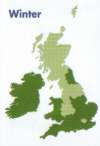Toms, M. 2003. The BTO/CJ Garden BirdWatch Book. Thetford, British Trust for Ornithology. ISBN 1-902576-73-X.
Softback. 24.5x17.0cm. 128 pages.
Although this is a 'serious' book (as you would expect from a learned organisation like the
British Trust for Ornithology), it is nonetheless written in a style which does
not make heavy reading. It was designed, in part, as a resource for those participating in the BTO's national 'Garden Birdwatch Survey' (which is open to all).
The book is split into three main sections: 'gardens for birds', 'garden bird ecology' and 'species accounts'. The 'gardens for birds' section covers a wide range of subjects from wildlife-friendly gardening through feeder hygiene to garden bird surveys. The wildlife gardening subjects are covered well enough to have merited this book's inclusion in the
Wildlife Gardening reference section of SpaceForNature, but in the end the book is primarily about the bird ecology.
 The 'garden bird ecology' section will fascinate readers who enjoy watching garden birds
The 'garden bird ecology' section will fascinate readers who enjoy watching garden birds
The 'garden bird ecology' section will fascinate readers who enjoy watching garden birds but have never been exposed to the 'science bit' before. Again
 I was impressed by the writing style which kept the subject matter accessible without dumbing-down
I was impressed by the writing style which kept the subject matter accessible without dumbing-down
I was impressed by the writing style which kept the subject matter accessible without dumbing-down in the least. Bird behaviour, the daily cycle, annual patterns, movement/migration and mortality are all covered here. Much of the information draws on the results of the BTO's various garden bird surveys including the Garden Birdwatch and the Garden Bird Feeding Survey (the longest running annual garden bird survey in Europe).
 Different shades of green reflect the garden incidence of each species.
Different shades of green reflect the garden incidence of each species. Fifty-two birds are covered in considerable detail with at least one full page each
Fifty-two birds are covered in considerable detail with at least one full page each
The final 'species accounts' section, the largest in the book, looks at the topics introduced in the previous two sections on a species by species basis. Fifty-two birds are covered in considerable detail with at least one full page each (but many have two). As well as the main text for each species, there is a summary panel which lists the population status, foods and breeding statistics (how many eggs are laid, how long young
remain in the nest etc.). This panel also includes a map showing the summer distribution and another the winter, as well as a graph showing how numbers change in the garden over the course of a season.
While I was reading how reed bunting peak in gardens during late spring when seed availability in farmland is at its lowest, I was minded of the single reed bunting I've seen in my own garden. Sure enough, when I checked back to see when it had occurred, it was at precisely that time of year (see diary entry for
28th March 2003). It brought home to me the value of the book:
 what I had previously thought of as a fortunate chance visit, I could now see in the broader context of the reed bunting's population ecology
what I had previously thought of as a fortunate chance visit, I could now see in the broader context of the reed bunting's population ecology
what I had previously thought of as a fortunate chance visit, I could now see in the broader context of the reed bunting's population ecology. For me, and for many other garden naturalists, the book can make experiences like these so much more resonant.
 glossy covers and good quality paper give these books a real feeling of substance in the hand
glossy covers and good quality paper give these books a real feeling of substance in the hand
In common with another recent book from the BTO,
The BTO Nestox Guide, the production is excellent; nicely laid out and well organised. Although relatively thin paperback volumes, glossy covers and good quality paper give these books a real feeling of substance in the hand.